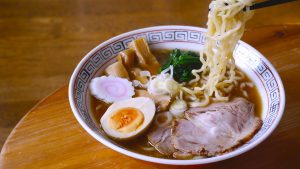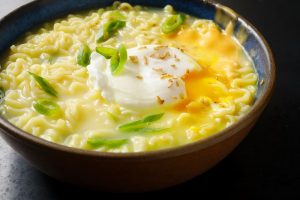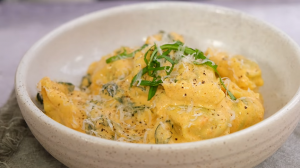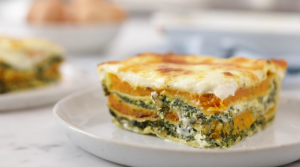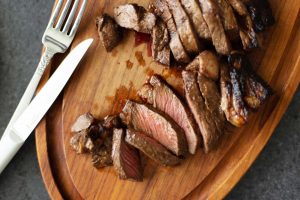Embark on a culinary journey to East Asia with this homemade chicken ramen recipe. This dish, known for its rich flavors and comforting broth, is a staple in Japanese cuisine. With fresh vegetables, tender chicken, and perfectly cooked ramen noodles, you'll find yourself in a flavorful haven.
While most ingredients in this recipe are common household staples, there might be a few that need special attention. Ramen noodles, traditionally used in East-Asian dishes, can be found in the Asian aisle of most supermarkets or at an Asian grocery store. Shiitake mushrooms, with their distinctive flavor, are also usually available in the produce section. If you can't find them, feel free to substitute with button or cremini mushrooms.
Ingredients for Homemade Chicken Ramen
Sesame oil: Used for sautéing, it adds a distinct nutty flavor to the broth.
Scallions: Adds a mild onion flavor, used both for the broth and garnishing.
Garlic: Enhances the overall flavor of the broth.
Carrot: Adds sweetness and color to the broth.
Mushrooms: Provides an earthy flavor.
Napa cabbage, spinach, kale: Adds nutritional benefits and texture to the dish.
Ginger: Gives a refreshing and spicy touch to the broth.
Chicken broth: The main liquid base of the ramen, providing a rich flavor.
Brown sugar: Balances out the savory flavors with a touch of sweetness.
Eggs: Provides a protein-packed addition to the ramen, boiled to your liking.
Ramen noodles: The main component of the dish, they're hearty and absorb the flavors of the broth well.
Chicken breast: Provides lean protein to the dish, cooked separately and added as a topping.
Soy sauce, Sriracha, cilantro, lime wedges: Used for garnishing, allowing you to adjust the flavors according to your preference.
One reader, Carline Bankston says:





This homemade chicken ramen recipe is a game-changer! The broth is rich and flavorful, and the combination of tender chicken, perfectly cooked eggs, and slurp-worthy noodles is simply divine. The garnishes add a burst of freshness. It's a comforting and satisfying meal that's perfect for any occasion. Highly recommended!
Key Techniques for Mastering Homemade Chicken Ramen
How to make the broth: This involves sautéing the vegetables, adding the broth, and simmering for 10 minutes to develop the flavors. How to cook the eggs: This involves boiling the eggs for a specific amount of time, then transferring them to cold water to stop the cooking process. How to cook the noodles: This involves boiling the noodles for 3 minutes or according to the package directions until they are tender. How to assemble the soup: This involves dividing the noodles among bowls, ladling the broth and vegetables over the noodles, and topping each bowl with egg halves and sliced chicken.
How To Make Homemade Chicken Ramen
A bowl of warm and flavorful chicken ramen is perfect for a late-night dinner or snack. Add a few green vegetables for a healthier broth.
Serves:
Ingredients
For the Broth:
- 2tbspsesame oil,toasted
- 4scallions,thinly sliced, including some of the green part
- 1garlic clove,minced
- 1small carrot,peeled and thinly sliced
- 4ozbutton,cremini or shiitake mushrooms, thinly sliced
- 1½cupsNapa cabbage,spinach, kale or other greens, thinly shredded
- 1ginger,fresh minced
- 6cupschicken broth,low-sodium, store-bought or homemade
- 1tbspbrown sugar,optional
- lime wedges,optional
For the Soup:
- 4large eggs
- 20ozramen noodles,fresh or 12 dried noodles
- 2medium chicken breast,cooked halves, sliced
For the Garnish:
- soy sauce
- sriracha,or other hot sauce
- cilantro,fresh handful, leaves removed from stems
- lime wedges
Instructions
-
In a large saucepan over medium heat, heat the oil. Add the scallions, garlic, carrot, mushrooms, and cabbage. Cook, stirring often, for 3 minutes or until the vegetables soften.
-
Stir in the ginger and brown sugar (if using) and cook for 30 seconds. Finally, add the chicken broth and bring it to a simmer. Simmer for 10 minutes.
-
While the broth is simmering, bring a pot of water to a boil. Set a bowl of cold ice water nearby.
-
Use a slotted spoon to gently lower the eggs, still in the shell, into the water. Simmer for 7 minutes for eggs that are soft and a little runny in the center, or 9 minutes for hard-boiled eggs.
-
Transfer the eggs to the bowl of cold water and set aside until ready to serve.
-
Return the pot of water to a boil. Add the noodles and cook for 3 minutes, or according to the package directions, until tender. Drain in a colander.
-
Divide the noodles among 4 large bowls. Ladle the broth and vegetables over the noodles. Remove the eggs from the ice water.
-
Tap the shells with a spoon to crack and then peel off the shells. Pat the eggs dry and cut them in half. Top each bowl with the egg halves and the sliced chicken.
-
Serve with soy sauce, hot sauce, cilantro leaves, and lime wedges.
Nutrition
- Calories: 1076.32kcal
- Fat: 49.15g
- Saturated Fat: 17.56g
- Trans Fat: 0.20g
- Monounsaturated Fat: 18.73g
- Polyunsaturated Fat: 9.47g
- Carbohydrates: 108.53g
- Fiber: 6.10g
- Sugar: 12.74g
- Protein: 49.29g
- Cholesterol: 252.48mg
- Sodium: 3304.54mg
- Calcium: 136.71mg
- Potassium: 1166.11mg
- Iron: 8.92mg
- Vitamin A: 301.38µg
- Vitamin C: 24.36mg
One Simple Technique to Elevate Your Ramen Game
When preparing your chicken for the ramen, consider poaching it in the broth for added flavor. Simply add the chicken breasts to the broth during the last 10-15 minutes of simmering. This not only cooks the chicken, but also allows it to absorb the flavors of the broth, resulting in a more flavorful and juicy chicken. Once cooked, remove the chicken from the broth, let it cool slightly, and then slice it thinly before adding it to your ramen bowls. This method also adds extra depth to your broth.
Time-Saving Tips for Making This Ramen Recipe
Prep ahead: Chop and prepare all the vegetables and ingredients in advance to save time during the cooking process.
Use store-bought broth: To save time, you can use pre-made chicken broth instead of making it from scratch.
Quick-cook eggs: Use an electric pressure cooker to quickly cook the eggs for the ramen, saving time and effort.
Pre-cooked chicken: Utilize pre-cooked rotisserie chicken or leftover grilled chicken to cut down on cooking time.
Instant noodles: Consider using instant ramen noodles for a quicker cooking process.
Organize ingredients: Arrange all the ingredients and utensils in an organized manner before starting the cooking process to streamline the preparation.
Substitute Ingredients For Homemade Chicken Ramen Recipe
sesame oil - Substitute with peanut oil: Peanut oil has a similar nutty flavor and high smoke point, making it a suitable substitute for sesame oil in the broth.
scallions - Substitute with chives: Chives have a mild onion flavor similar to scallions and can be used as a garnish for the ramen.
garlic - Substitute with garlic powder: If fresh garlic is not available, garlic powder can be used in the broth for a similar flavor.
carrot - Substitute with sweet potato: Sweet potatoes can add a slightly sweet and earthy flavor to the broth, similar to carrots.
mushrooms - Substitute with oyster mushrooms: Oyster mushrooms have a similar texture and umami flavor to button or cremini mushrooms, making them a good substitute.
napa cabbage - Substitute with bok choy: Bok choy has a similar mild, slightly bitter flavor and can be used as a substitute for napa cabbage in the ramen.
ginger - Substitute with ground ginger: Ground ginger can be used as a substitute for fresh ginger in the broth, providing a similar warm and spicy flavor.
chicken broth - Substitute with vegetable broth: Vegetable broth can be used as a substitute for chicken broth to make a vegetarian version of the ramen.
brown sugar - Substitute with honey: Honey can add a touch of sweetness to the broth, similar to brown sugar.
eggs - Substitute with tofu: Tofu can be used as a protein substitute for eggs in the ramen soup, providing a vegetarian option.
ramen noodles - Substitute with soba noodles: Soba noodles can be used as a substitute for ramen noodles, providing a nutty flavor and a different texture to the dish.
chicken breast - Substitute with tofu or tempeh: Tofu or tempeh can be used as a vegetarian substitute for chicken in the ramen soup.
soy sauce - Substitute with tamari: Tamari is a gluten-free alternative to soy sauce and can be used as a substitute for a similar umami flavor.
sriracha - Substitute with chili garlic sauce: Chili garlic sauce can be used as a substitute for sriracha, providing a similar spicy kick to the ramen.
cilantro - Substitute with parsley: Parsley can be used as a substitute for cilantro, providing a fresh herb flavor to the ramen.
lime wedges - Substitute with lemon wedges: Lemon wedges can be used as a substitute for lime wedges to add a citrusy flavor to the ramen.
How to Beautifully Present Homemade Chicken Ramen
Elevate the broth: Create a clear and flavorful chicken broth by infusing it with the aromatic flavors of sesame oil, scallions, garlic, carrot, mushrooms, and napa cabbage. The broth should be rich, fragrant, and visually appealing.
Perfectly cooked eggs: Prepare the eggs to perfection, ensuring they are soft and runny in the center. The eggs should be carefully peeled and halved, presenting a beautiful and appetizing visual element to the dish.
Artfully arranged noodles: Carefully portion and arrange the ramen noodles in each bowl, ensuring they are visually appealing and inviting. The noodles should be cooked to perfection, with a pleasing texture and appearance.
Tender and succulent chicken: Slice the chicken breast into thin, tender pieces and artfully arrange them on top of the noodles. The chicken should be perfectly cooked, moist, and flavorful, adding a delightful protein element to the dish.
Garnish with precision: Add a touch of finesse to the dish by garnishing with a drizzle of soy sauce, a hint of sriracha, fresh cilantro leaves, and a wedge of lime. Each garnish should be carefully placed to enhance the visual appeal and flavor profile of the dish.
Essential Tools for Crafting the Perfect Ramen Bowl
Saucepan: A saucepan is a deep cooking pan with a long handle, used for cooking soups, sauces, and boiling liquids.
Slotted spoon: A slotted spoon is a kitchen utensil with holes or slots that allow liquid to pass through while retaining larger solids.
Colander: A colander is a bowl-shaped kitchen utensil with perforations for draining liquids from food, such as pasta or vegetables.
Pot: A pot is a deep, round container used for cooking food on a stovetop or in an oven.
Bowl: A bowl is a round, deep dish used for serving or mixing food.
Knife: A knife is a sharp-edged tool used for cutting or slicing ingredients.
Cutting board: A cutting board is a durable board used for cutting and preparing food.
Colander: A colander is a bowl-shaped kitchen utensil with perforations for draining liquids from food, such as pasta or vegetables.
Slotted spoon: A slotted spoon is a kitchen utensil with holes or slots that allow liquid to pass through while retaining larger solids.
Mixing bowl: A mixing bowl is a deep bowl used for combining ingredients.
Food processor: A food processor is an electric kitchen appliance used for chopping, blending, or pureeing ingredients.
Strainer: A strainer is a kitchen tool used for separating liquids from solid ingredients.
Whisk: A whisk is a kitchen utensil used for whipping, beating, and stirring ingredients.
Measuring cup: A measuring cup is a kitchen tool used to measure liquid or dry ingredients.
Tongs: Tongs are a kitchen tool consisting of two arms joined by a hinge, used for picking up and holding food.
Grater: A grater is a kitchen tool used for shredding or grating ingredients such as cheese or vegetables.
Peeler: A peeler is a kitchen tool used for removing the outer skin or peel of fruits and vegetables.
Ladle: A ladle is a long-handled spoon with a deep bowl, used for serving soups, stews, and sauces.
Chopping board: A chopping board is a durable board used for cutting and preparing food.
Skimmer: A skimmer is a kitchen utensil with a perforated or slotted bowl used for skimming liquids or lifting solid ingredients from a cooking liquid.
Spatula: A spatula is a kitchen tool with a broad, flat, flexible blade, used for lifting, spreading, or flipping ingredients.
Sieve: A sieve is a kitchen tool used for sifting dry ingredients or straining liquids.
Rolling pin: A rolling pin is a cylindrical kitchen tool used for flattening and shaping dough.
Oven: An oven is a kitchen appliance used for baking, roasting, and heating food.
Stove: A stove is a kitchen appliance used for cooking food, typically with a cooktop and oven.
Grill: A grill is a cooking appliance used for grilling or barbecuing food.
Blender: A blender is a kitchen appliance used for blending, pureeing, or emulsifying ingredients.
Mortar and pestle: A mortar and pestle are tools used for grinding and crushing ingredients, such as spices or herbs.
Saucepan: A saucepan is a deep cooking pan with a long handle, used for cooking soups, sauces, and boiling liquids.
Skillet: A skillet is a frying pan with a flat bottom and low sides, used for frying, searing, and sautéing.
Saucepan: A saucepan is a deep cooking pan with a long handle, used for cooking soups, sauces, and boiling liquids.
Storing and Freezing Your Homemade Chicken Ramen
- To store leftover chicken ramen, allow the soup to cool to room temperature before transferring it to an airtight container. Store the container in the refrigerator for up to 3-4 days.
- When storing, it's best to keep the noodles, broth, and toppings separate to prevent the noodles from becoming soggy. Store the noodles in a separate airtight container in the refrigerator.
- To reheat the ramen, place the desired portion of broth in a saucepan and heat it over medium heat until it reaches a simmer. Add the noodles and cook for 1-2 minutes, or until they are heated through. Add your desired toppings and serve immediately.
- If you want to freeze the ramen for later consumption, it's best to freeze the broth separately from the noodles and toppings. Allow the broth to cool completely before transferring it to a freezer-safe container or a resealable freezer bag. Remove as much air as possible from the bag before sealing to prevent freezer burn. Label the container or bag with the date and store it in the freezer for up to 2-3 months.
- To freeze the chicken, slice it or shred it and place it in a separate freezer-safe container or bag. Store it in the freezer for up to 2 months.
- When you're ready to enjoy the frozen ramen, thaw the broth and chicken in the refrigerator overnight. Reheat the broth in a saucepan over medium heat until it reaches a simmer. Cook the noodles separately and add them to the hot broth along with the thawed chicken and your desired toppings.
- It's not recommended to freeze the noodles, as they tend to become mushy and lose their texture when thawed. It's best to cook fresh noodles when you're ready to serve the ramen.
The Best Methods for Reheating Leftover Ramen
Reheat the broth in a saucepan over medium heat until it reaches a simmer. This will help to revive the flavors and ensure that the broth is hot when you serve the ramen.
If you have stored the noodles separately, reheat them by placing them in a colander and pouring boiling water over them. Let the noodles sit for a minute or two to heat through, then drain well before adding them to the hot broth.
If the noodles were stored together with the broth, you can reheat them together in the saucepan. However, keep in mind that the noodles may become slightly softer than when they were first cooked.
Reheat the chicken and any other toppings (such as vegetables or eggs) separately in the microwave or a skillet until they are heated through. This will help to maintain their texture and prevent them from becoming overcooked or soggy.
Once all the components are heated, assemble the ramen bowls by placing the noodles in the bottom, ladling the hot broth over them, and arranging the toppings on top.
If you find that the broth has thickened or concentrated too much during storage, you can thin it out with a little water or additional chicken broth while reheating.
To add some extra flavor and freshness to your reheated ramen, consider garnishing with fresh herbs like cilantro or scallions, a squeeze of lime juice, or a drizzle of sesame oil.
Surprising Facts About Homemade Chicken Ramen
The homemade chicken ramen recipe is a popular dish in Japan and has gained popularity worldwide. It is a versatile dish that can be customized with various toppings and flavors, making it a favorite among food enthusiasts. The dish is not only delicious but also nutritious, as it contains a variety of vegetables and lean protein. It is a comforting and satisfying meal that can be enjoyed at any time of the year.
Is Making Chicken Ramen at Home Cost-Effective?
The cost-effectiveness of this homemade chicken ramen recipe is quite high. The ingredients, including chicken breast, ramen noodles, and vegetables, are generally affordable and readily available. The recipe offers a satisfying and flavorful meal for a household of 4 at an approximate cost of $20. The use of simple, fresh ingredients and the ability to customize the dish to personal preferences make it a practical and economical choice for home cooking. Overall Verdict: 9.
Is This Ramen Dish Healthy or Not?
This homemade chicken ramen recipe has both healthy and unhealthy aspects. On the positive side, it includes a variety of vegetables such as scallions, garlic, carrots, mushrooms, and leafy greens, which provide essential vitamins, minerals, and fiber. The chicken breast is a lean protein source, and the eggs add additional protein and nutrients. The use of sesame oil and ginger can also provide anti-inflammatory benefits.
However, the recipe also has some less healthy components. Ramen noodles are typically high in refined carbohydrates and low in fiber, which can cause blood sugar spikes and provide limited nutritional value. The chicken broth, depending on the brand or preparation method, may be high in sodium, which can contribute to high blood pressure and other health issues if consumed in excess. Additionally, the recipe calls for brown sugar, which adds extra calories and sugar to the dish.
To make this recipe healthier, consider the following suggestions:
- Swap regular ramen noodles for whole grain or vegetable-based noodles to increase fiber content and reduce refined carbohydrates
- Use low-sodium chicken broth or make your own to control the amount of salt in the dish
- Reduce or omit the brown sugar to decrease added sugar content
- Increase the proportion of vegetables to noodles to boost the nutrient density of the meal
- Opt for skinless chicken breast to reduce saturated fat intake
- Use a moderate amount of sesame oil, as it is high in calories despite its health benefits
- Add additional herbs and spices, such as turmeric or red pepper flakes, to enhance flavor and provide more antioxidants
Our Editor's Honest Opinion on This Chicken Ramen Recipe
The homemade chicken ramen recipe is a delightful fusion of flavors and textures. The aromatic broth, infused with sesame oil and ginger, creates a rich base for the tender chicken, earthy mushrooms, and vibrant vegetables. The soft-boiled eggs add a luscious creaminess, while the chewy ramen noodles provide a comforting bite. The garnishes of soy sauce, sriracha, cilantro, and lime wedges offer a perfect balance of savory, spicy, and citrusy notes. This recipe is a culinary masterpiece that will surely impress and satisfy any ramen enthusiast.
Enhance Your Homemade Chicken Ramen Recipe with These Unique Side Dishes:
Delicious Alternatives to Traditional Chicken Ramen
Appetizer and Dessert Ideas to Complement Your Ramen
Why trust this Homemade Chicken Ramen Recipe:
This recipe is a testament to the art of homemade chicken ramen. The carefully selected ingredients, such as sesame oil, shiitake mushrooms, and ginger, ensure an authentic and flavorful experience. The step-by-step instructions guarantee a successful outcome, and the use of fresh ingredients and traditional techniques reflects a commitment to quality. Trust in the expertise and passion behind this recipe, and savor the delightful combination of soy sauce, sriracha, and cilantro that elevate the dish to a culinary masterpiece.
Was this page helpful?
Have your own special recipe to share? Submit Your Recipe Today!




